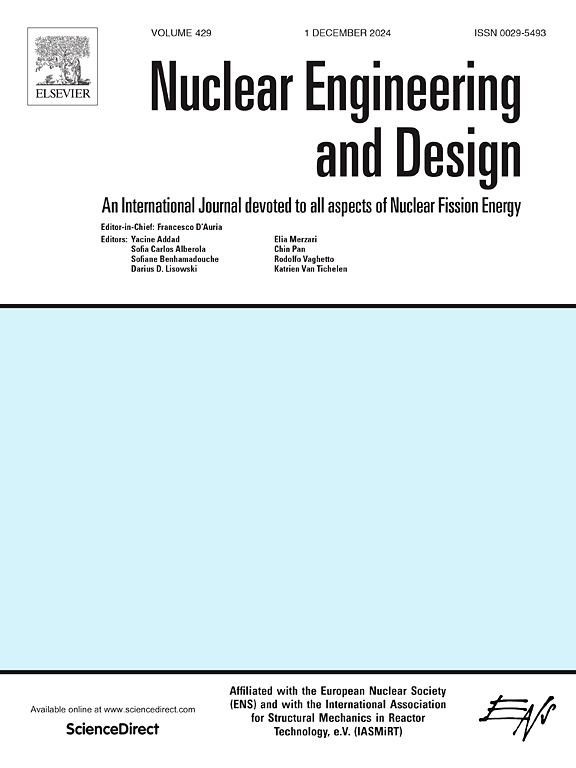整合机器学习模型,加强废弃密封放射源的放射性废物管理
IF 1.9
3区 工程技术
Q1 NUCLEAR SCIENCE & TECHNOLOGY
引用次数: 0
摘要
本研究提出了一种新的机器学习方法,通过先进的预测建模来优化废弃密封放射源(DSRS)的放射性废物管理。该研究利用了来自放射性废物处理设施(IPLR)的综合数据,将1,339行实际操作数据与9,994行合成数据相结合,以开发强大的预测框架。采用先进的预处理技术,如SMOTE和ADASYN,我们实现了五个分类模型(决策树,k-近邻(kNN), CatBoost,卷积神经网络(CNN)和长短期记忆(LSTM))作为重用识别分类模型的一部分,该模型对重用DSRS的可能性进行了分类。随后,采用Ridge回归、Lasso回归和Random Forest回归三种回归模型,对基于衰减趋势和活动水平的长期可用性进行评估。我们的研究结果表明,kNN优于其他分类器,达到0.987的AUC-ROC,而Ridge回归和随机森林产生接近完美的r平方值,显示出优越的长期预测精度。这项研究表明,机器学习有可能通过准确预测重用机会和估计长期需求来改善DSRS管理。真实数据和合成数据的结合产生了有助于提供更具操作性和数据驱动的放射性废物管理计划的模型。研究结果对决策者和其他利益攸关方作出明智决策以提高放射性废物处理的可持续性和安全性具有重要意义。本文章由计算机程序翻译,如有差异,请以英文原文为准。

Integration of machine learning models for enhancing radioactive waste management of disused sealed radioactive sources
This research presents a novel machine-learning approach for optimizing the radioactive waste management of Disused Sealed Radioactive Sources (DSRS) through advanced predictive modelling. The study leverages comprehensive data from the Radioactive Waste Treatment Facility (IPLR), combining 1,339 rows of real operational data with 9,994 rows of synthetic data to develop robust prediction frameworks. Employing advanced preprocessing techniques such as SMOTE and ADASYN, we implemented five classification models (Decision Tree, k-Nearest Neighbors (kNN), CatBoost, Convolutional Neural Network (CNN), and Long Short-Term Memory (LSTM)) as part of the Reuse Identification Classification Model, which categorizes the likelihood of reusing DSRS. Subsequently, three regression models (Ridge Regression, Lasso Regression, and Random Forest) were applied in the Long-Term Utilization Regression Model to estimate long-term usability based on decay trends and activity levels. Our findings reveal that kNN outperforms other classifiers, achieving an AUC-ROC of 0.987, while Ridge Regression and Random Forest yield nearly perfect R-squared values, demonstrating superior long-term prediction accuracy. This study shows that machine learning has the possibility to improve DSRS management by accurately predicting reuse opportunities and estimating long-term requirements. A combination of real and synthetic data has produced models that aid in providing a more operational and data-driven radioactive waste management scheme. The results are significant for policymakers and other stakeholders in making informed decisions to enhance the sustainability and safety of radioactive waste handling.
求助全文
通过发布文献求助,成功后即可免费获取论文全文。
去求助
来源期刊

Nuclear Engineering and Design
工程技术-核科学技术
CiteScore
3.40
自引率
11.80%
发文量
377
审稿时长
5 months
期刊介绍:
Nuclear Engineering and Design covers the wide range of disciplines involved in the engineering, design, safety and construction of nuclear fission reactors. The Editors welcome papers both on applied and innovative aspects and developments in nuclear science and technology.
Fundamentals of Reactor Design include:
• Thermal-Hydraulics and Core Physics
• Safety Analysis, Risk Assessment (PSA)
• Structural and Mechanical Engineering
• Materials Science
• Fuel Behavior and Design
• Structural Plant Design
• Engineering of Reactor Components
• Experiments
Aspects beyond fundamentals of Reactor Design covered:
• Accident Mitigation Measures
• Reactor Control Systems
• Licensing Issues
• Safeguard Engineering
• Economy of Plants
• Reprocessing / Waste Disposal
• Applications of Nuclear Energy
• Maintenance
• Decommissioning
Papers on new reactor ideas and developments (Generation IV reactors) such as inherently safe modular HTRs, High Performance LWRs/HWRs and LMFBs/GFR will be considered; Actinide Burners, Accelerator Driven Systems, Energy Amplifiers and other special designs of power and research reactors and their applications are also encouraged.
 求助内容:
求助内容: 应助结果提醒方式:
应助结果提醒方式:


